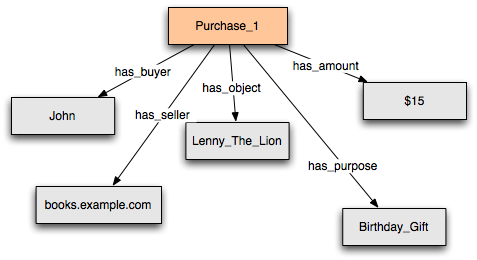-
Notifications
You must be signed in to change notification settings - Fork 61
New issue
Have a question about this project? Sign up for a free GitHub account to open an issue and contact its maintainers and the community.
By clicking “Sign up for GitHub”, you agree to our terms of service and privacy statement. We’ll occasionally send you account related emails.
Already on GitHub? Sign in to your account
Connection is now modeled as an Activity, should we model is as a reified statement? #99
Comments
|
@jasnell please take a look at diagrams I just did around reification, relations, qualified relations and activities |
|
@elf-pavlik that doesn't actually help address the question. On the call today it was decided to remodel the existing "Connect" and "FriendRequest" Activity types into a "Connection" object. That Connection object has to be able to describe a connection between two individuals. Such an object is naturally a form of reified statement. The question is only if we want to formally model it as such. |
|
I think we do want to use reified statements and reuse predicates. It will also come handy when we query. Since systems can have both qualified and non qualified relations in used dataset. @prefix : <https://example.vocab/>
@prefix rdf: <http://www.w3.org/1999/02/22-rdf-syntax-ns#> .
@prefix rdfs: <http://www.w3.org/2000/01/rdf-schema#> .
@prefix owl: <http://www.w3.org/2002/07/owl#> .
@prefix foo: <http://example.foo/> .
:QualifiedRelation a owl:Class .
:Connection a owl:Class ;
rdfs:subClassOf rdf:Statement ;
rdfs:subClassOf :QualifiedRelation .
:Following a owl:Class ;
rdfs:subClassOf :Connection .
foo:elf-pavlik a :Person .
foo:jasnell a :Person .
foo:elf-pavlik-followed-jasnell a as:Follow ;
as:actor foo:elf-avlik ;
as:object foo:jasnell ;
as:result foo:elf-pavlik-following-jasnell .
#qualified relation
foo:elf-pavlik-following-jasnell a :Following ;
rdf:predicate :follow ;
rdf:subject foo:elf-avlik ;
rdf:object foo:jasnell ;
# additional unqualified relation for ease of querying
#(most comnonly used in already existing data)
foo:elf-pavlik :follows :foo:jasnell .
Please also notice :Following as result of :Follow #94 |
|
I also started similar diagrams for Container #82 which also uses pattern similar to reification. I use ldp:DirectContainer and this way again we can reuse same predicates to follow our nose to containers with people i follow or who follow me 😄
|
|
I also suggest reading Defining N-ary Relations on the Semantic Web Use Case 3 of N-ary Relation looks very much like as:Activity |
|
While working on Travel with actor staying multiple times in the same city. I found need that a qualified relation links to relevant activities which provide more detailed timeline. Similar can happen with Connection to another agent. I can Follow/Unfollow, Friend/Unfriend etc. multiple times. So Qualified Relation(s) between two agents serve distinct purpose than Activitiy(ies) which happen between them. I don't see question "should we use one or the other?" a proper one here. Instead I think both have its place and we just need to clearly define and explain how one relates to the other... |

e.g.
{
"@type": "Connection",
"a": "acct:john@example.org",
"predicate": "foaf:knows",
"b": "acct:sally@example.org"
}
where
aandbare subproperties ofrdf:subjectandrdf:objectandpredicateis a subproperty ofrdf:predicate. This allows us to easily reuse other existing vocabularies for describing relationship types.The text was updated successfully, but these errors were encountered: